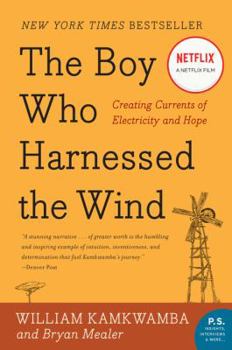The Boy Who Harnessed the Wind: Creating Currents of Electricity and Hope
Select Format
Select Condition 
Book Overview
Now a Netflix Film, Starring and Directed by Chiwetel Ejiofor of 12 Years a Slave William Kamkwamba was born in Malawi, a country where magic ruled and modern science was mystery. It was also a land withered by drought and hunger. But William had read about windmills, and he dreamed of building one that would bring to his small village a set of luxuries that only 2 percent of Malawians could enjoy: electricity and running...
Format:Paperback
Language:English
ISBN:0061730335
ISBN13:9780061730337
Release Date:July 2010
Publisher:William Morrow & Company
Length:320 Pages
Weight:0.57 lbs.
Dimensions:0.8" x 5.3" x 7.8"
Age Range:11 to 17 years
Grade Range:Grades 6 to 12
Customer Reviews
5 ratings
An amazing story of determination and hope
Published by Thriftbooks.com User , 15 years ago
After barely surviving a famine in Malawi (sub-Saharan Africa), 14-year-old William Kamkwamba was determined to find a way to make life better for himself and his family. What if he could somehow bring electricity to his village, to pump water for crops in times of drought? Using diagrams in an old forgotten science book called "Using Energy" that he found in a grade school library, he cobbled together a contraption out of scraps and junk that worked to power a few light bulbs -- and changed the life of his village forever. His neighbors, steeped in superstition and with little or no knowledge of science, thought him crazy. But he had a gift for mechanical things, he understood the principles, and he knew he could do it. And he did. Eventually he got a second windmill going, powering a a water pump from a deep well, which is now used by all the women in the village. Today every house there has a solar panel and a battery to store electricity, too. But this is much more than a story about an African boy who built a working windmill. It's a monument to the human spirit. In fact, we don't even get to making the windmill itself until halfway through the book. In the first half, William tells us a lot about his life in Africa, the terrible famine that swept his land, how he and his family survived, and the clues along the way which eventually led to him making the windmill. Even as a little kid, he was taking apart radios to see how they worked -- with no books or training, just trial and error. Then he saw a bicycle light that ran from a mechanical dynamo -- the kind that generates electricity when you pedal. Experimenting with this, he figured out how to get it to power his radio when he turned the bike pedals. When he finally found a picture of a windmill in the "Using Energy" book, it all came together. "In my mind I saw the dynamo," he explains, "saw myself with my neighbor's bicycle those many nights ago, spinning the pedals so I could listen to the radio... The wind would spin the blades of the windmill, rotating the magnets in the dynamo, and then creating current. Attach a wire to the dynamo and you could power anything..." Sounds simple? In principle, yes -- but there is no local Radio Shack in a Malawi village for William to go get the parts. He must make do with what he can scrounge -- and that's the really amazing part of this story. Step by step, Willam explains what he needed for the windmill, how he adapted things he found in the junkyard, or took odd jobs to get money to buy what he could not make. Some simple tasks took three or four hours because he did not have the right tools and had to improvise. But he kept at it. All in all, he probably put a hundred or more hours into this project. Talk about determination! As I read the story, I could not help thinking how wasteful we are here in America. Over an over, I was astonished at William's creativity in finding uses for things I would have considered useless
An amazing story of determination and hope
Published by Thriftbooks.com User , 15 years ago
After barely surviving a famine in Malawi (sub-Saharan Africa), 14-year-old William Kamkwamba was determined to find a way to make life better for himself and his family. What if he could somehow bring electricity to his village, to pump water for crops in times of drought? Using diagrams in an old forgotten science book called "Using Energy" that he found in a grade school library, he cobbled together a contraption out of scraps and junk that worked to power a few light bulbs -- and changed the life of his village forever. His neighbors, steeped in superstition and with little or no knowledge of science, thought him crazy. But he had a gift for mechanical things, he understood the principles, and he knew he could do it. And he did. Eventually he got a second windmill going, powering a water pump from a deep well, which is now used by all the women in the village. Today every house there has a solar panel and a battery to store electricity, too. But this is much more than a story about an African boy who built a working windmill. It's a monument to the human spirit. In fact, we don't even get to making the windmill itself until halfway through the book. In the first half, William tells us a lot about his life in Africa, the terrible famine that swept his land, how he and his family survived, and the clues along the way which eventually led to him making the windmill. Even as a little kid, he was taking apart radios to see how they worked -- with no books or training, just trial and error. Then he saw a bicycle light that ran from a mechanical dynamo -- the kind that generates electricity when you pedal. Experimenting with this, he figured out how to get it to power his radio when he turned the bike pedals. When he finally found a picture of a windmill in the "Using Energy" book, it all came together. "In my mind I saw the dynamo," he explains, "saw myself with my neighbor's bicycle those many nights ago, spinning the pedals so I could listen to the radio... The wind would spin the blades of the windmill, rotating the magnets in the dynamo, and then creating current. Attach a wire to the dynamo and you could power anything..." Sounds simple? In principle, yes -- but there is no local Radio Shack in a Malawi village for William to go get the parts. He must make do with what he can scrounge -- and that's the really amazing part of this story. Step by step, Willam explains what he needed for the windmill, how he adapted things he found in the junkyard, or took odd jobs to get money to buy what he could not make. Some simple tasks took three or four hours because he did not have the right tools and had to improvise. But he kept at it. All in all, he probably put a hundred or more hours into this project. Talk about determination! As I read the story, I could not help thinking how wasteful we are here in America. Over and over, I was astonished at William's creativity in finding uses for things I would have considered useless j
Harnessing Hope.
Published by Thriftbooks.com User , 15 years ago
An incredible memoir about a young boy who becomes fascinated with the way things work. "How does this radio work?" ... "But HOW does it work?" From humble beginnings, William begins to figure out how to fix things, then create things, in turn creating a better life for himself and family and those around him. It doesn't read quite like the other memoirs I've read recently. It reads like a novel, you forget that these are events that actually happened. This kid lived through this and accomplished feats that many of us in the modern, developed world can only fathom. It would be unfair to cite too many examples but from his early questions comes his first experiments with figuring out how radios work. Using cheap batteries and found wire, he figures out the difference between AC and DC, why FM and AM are different, different sources of power... of course all this leads to creating MORE power. All in all, a really great book. William Morrow (publisher) has been putting out a lot of great memoirs lately. Good job on their part for finding all of these gems! I hope they keep it up.
Starving? No education? No power? Build a windmill. Absolutely amazing story.
Published by Thriftbooks.com User , 15 years ago
Caution: Some spoilers below. This is the most awe inspiring book I have read in years. William Kamkwamba is a tribute to human inventiveness and persistence. William grows up in a society in Africa that believes that witchcraft can cause children to steal people's heads and play soccer with them during the night (without the headless person even noticing). All around him people are quite literally starving to death, eating corn husks and sawdust in an attempt to stay alive during a famine. He does not attend school because his parents can not afford the tuition (you and I spend more on a pair of shoes). In spite of all this he gets a hold of some science textbooks, written in English, and teaches himself the basics of electricity and magnetism. He scavenges junk yards and begins to build a windmill. Almost everyone thinks he is slightly crazy, even his own family. Until he gets the windmill working and powers up some small lights for his home. Then they are lining up to charge up their cell phones from his "electric wind". (one does wonder why they have cell phones in such a poor country) The book reads well, his voice comes through the prose and at the end you have some understanding of how he accomplished this astounding feat. This book humbled me, made me cry and also laugh out loud. Highly recommended.
Inspiring true story of hope and invention set against Malawi's worst famine in 50 years
Published by Thriftbooks.com User , 15 years ago
You can't help but be moved by the tale of William Kamkwamba, a poor young Malawian boy who was forced to drop out of high school for lack of school fees. Rather than waste his life, he decided to educate himself via a small library at his former primary school. He sees the cover of a 5th grade textbook from the United States which depicts a windmill, and decides to build one to power his family's home, despite no knowledge of exactly how to do so and no money for parts. Whether he succeeds and what happens after I won't spoil here. Set against the backdrop of the country's worst famine in 50 years where people were literally starving to death, this story is also the journey of a boy who believes in magic as he becomes a young man of science. Co-written with journalist Bryan Mealer, the book reads like a novel. You'll find it lyrical, poignant and in parts, heartbreaking, but ultimately uplifting, hopeful and life-affirming. Perfect for anyone who enjoys thrilling and inspiring true-life tales. Besides general readers, I recommend "The Boy" for bookclubs, gifts, do-it-yourself enthusiasts (Makers!) and for middle school, high school and college readers. If you loved Greg Mortensen's "Three Cups of Tea," you'll love "The Boy Who Harnessed the Wind."
The Boy Who Harnessed the Wind: Creating Currents of Electricity and Hope Mentions in Our Blog

Reading Challenge: Reading About Different Cultures
Published by Bianca Smith • March 08, 2018
Living different lives, in the pages of books.






